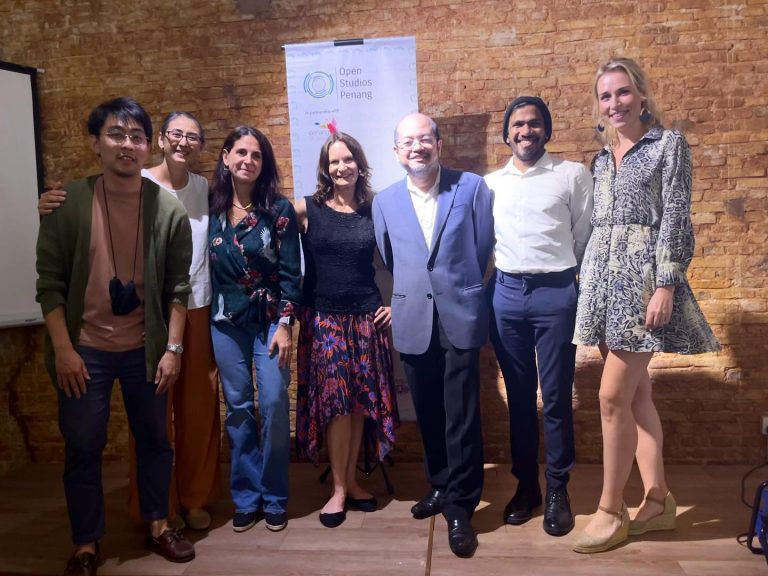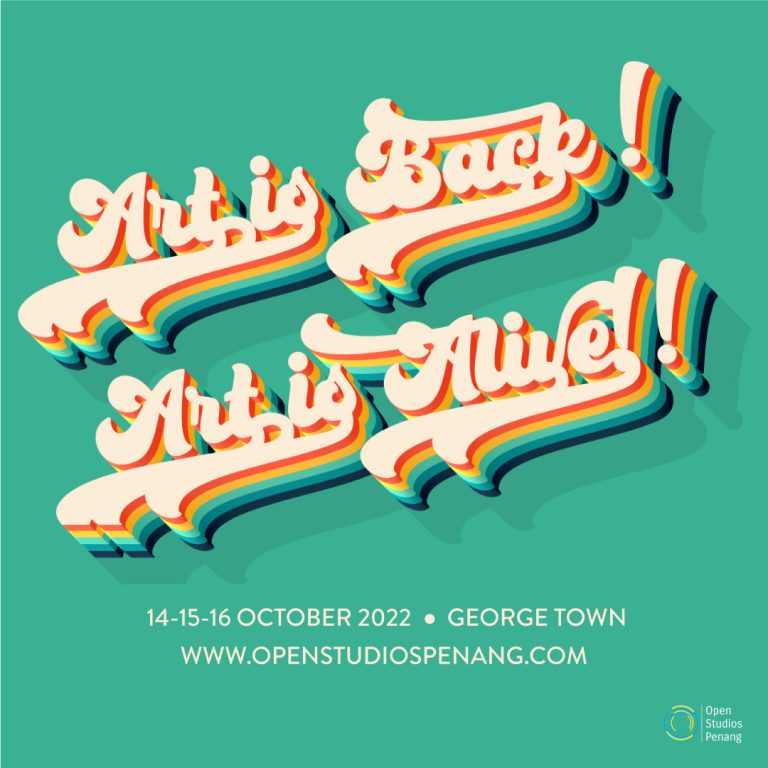As the biggest event of its kind in Penang, locals and tourists will bask in the delights of visual arts throughout its cityscapes, marking a reemergence of art in Penang.
By Miriam Devaprasana
Open Studios Penang (OSP) is back for its third iteration promising a feast for the senses. The weekend-long festival brings together over 60 emerging and established artists and artisans, each having a unique expression and perspective on art, technique, and media. In this way, OSP 2022 pays tribute to and spotlights the visual arts by showcasing an array of artistic approaches to the discipline.
With inclusivity and diversity as its pillars, OSP 2022 stands as a platform for artists from varied backgrounds, nationalities, styles, artistry, and age, with its youngest participants being 11 and 15. The festival includes several art forms, from photography, painting, and drawing, to sculpture, wood art, and digital creations. For the next three days, visitors will be able to appreciate the wide-ranging works and media skilfully expressed, captured, and made through imagination, creativity, observations, and storytelling.
As such, OSP 2022 acts as a nucleus for artists and the public, providing ample opportunity for engagement, exchange, and inspiration in shared spaces.

From left to right: Kenny Ng (PAD), Esther Geh (OSP Artist Liaison), Maria Pillar Juste (OSP Graphic Designer), Louise Goss-Custard (OSP Advisor and Co-ordinator), Lee Khai (Advisor, PAD), Ivan Gabriel (OSP Programme Curator), and Anneloes Leijssen (OSP Social Media and Publicity Manager) during the opening ceremony of Open Studios Penang 2022. Courtesy of Open Studios Penang, 2022.
Establishing Open Studios Penang
The idea of establishing OSP began as a conversation in 2018 among a group of 30 to 40 artists and art enthusiasts who saw the need for a greater appreciation of the local visual art scene and increased engagement between the artist(s) and the public. Although Penang played host to many festivals and events, visual art seemed to merely be an addition to the programme rather than a featured aspect. With a vision to bridge the gap, a core team of volunteers was set up to organise a non-profit annual event. Motivated by their love of art and love for Penang, the team adapted the concept of open studios to suit the local visual arts environment.
OSP organised their first edition in June 2019 to overwhelming success, seeing 90 participating artists across 30 venues over a weekend of exhibitions, talks, workshops, and an art trail. The positive responses spurred the team’s enthusiasm for their second edition, which would have opened in March 2020 if not for the Covid-19 pandemic. Despite the setback, the group pressed on towards the goal and began thinking about a third edition in January 2022. This was met with its fair share of challenges unique to the circumstances surrounding the past two years.

At the opening ceremony held on 13 October, Louise Goss-Custard, advisor, coordinator, and co-founder, noted how many artists struggled with the aftermath of the pandemic. Some were forced to leave the state and the country, while others stopped creating as they wrestled with isolation and loneliness. Some artists parted ways with their passion. Then there were friends in the industry whom we sadly lost to the pandemic. Therefore, when the restrictions eased in April, the team realised it was time for OSP to take place.
The Concept Behind The Name
An open studio is a platform where artists invite the public into their work and display spaces. Here, visitors are given the unique opportunity to observe, listen, and witness first-hand how the artist creates. Every open studio is considered a shared space, with comfort and accessibility in mind to prompt engagement between the artist and the public. This allows visitors to be a part of the environment, enabling conversations and promoting exchanges between all the participants.
With OSP 2022, it is clear that the organising team has thoughtfully considered ways the festival can reach out to the wider community. Where art is often viewed as exclusive, OSP breaks the traditional mould of how visual arts exhibitions and the culture surrounding them are practised.
Furthermore, it cannot be denied that Penang sorely lacks art galleries. Besides the Penang State Art Gallery, most available galleries are privately owned, often hosting private art collections. There is an atmosphere and a language these settings tend to call for. Unfortunately, these expectations further distance the general public and the art world—a cause for inaccessibility.
In recognising this, OSP 2022 features venues which act as alternative spaces suitable to host exhibitions of every kind, including cafes and open spaces such as Hin Bus Depot. Within these settings, exhibitions are seen as inviting, open, and less daunting. This creates a friendlier, more accessible, and more comfortable atmosphere for visitors to walk in and experience the works however they wish to do so.

Visitors at the opening ceremony and group exhibition for Open Studios Penang at Black Kettle. Image by Miriam Devaprasana.
Engaging with these spaces can also spur owners to build relationships with the artists on their own, adding opportunities for future art exhibitions and shows. This way, OSP acts as a starting point, facilitating artists and stakeholders to create sustainable and accessible forms of hosting exhibitions beyond OSP and other annual festivals or events.
Go Big, Go Bold
To further discourse surrounding the art world, OSP launched Open Galleries Penang (OGP), which will open between 4 to 6 November 2022. OGP will see a similar framework, bringing together ten galleries like Penang’s latest white-box gallery, Blank Canvas, and cafes such as Narrow Marrow and China House. These spaces will host a number of solo exhibitions, and a private art collection, with the hopes that this will encourage a different way of engaging with existing art galleries and settings in Penang. In this way, OGP lays a foundation towards asking essential questions like “what constitutes an art gallery” and “how should galleries be fitted for accessibility?”. These are vital considerations, especially in a state which aims to become the premier art destination in the country and region.
Since its inscription as a UNESCO Heritage Site, Penang’s history and heritage has received greater attention, becoming a commodity for tourism and the economy. Many flock to the inner city for its street mural art and iron rod sculptures, noting the uniqueness of narrative, medium, and representation. However, street art is merely the tip of Penang’s visual and performing arts industry. As much as it draws people in, attention should be given to creating supportive, sustainable, and accessible environments to facilitate healthy growth in the art industry, particularly post-pandemic.
OSP contributes to the narrative by introducing and reacquainting the public with the local arts scene. It also bridges artists, the public, and stakeholders, forming connections and building relationships to ensure that visual art receives the attention it deserves. In this way, OSP lays foundational work as a movement by artists, art lovers, and advocates who bring back a sense of presence and inject vitality into the local visual arts scene.
Miriam Devaprasana is an observer and dabbler of creative expressions. She is currently pursuing a PhD in Urban Sociolinguistics and hopes that one day, her work will help form a new way of thinking ‘Malaysia’. Read her blog at mdev16.wordpress.com

